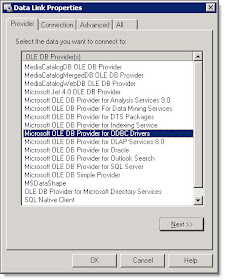In an attempt to challenge Steve's dominance of the blog lately, I thought I would share a reminder of sorts as it relates to the Dynamics database. I know I am guilty of sometimes minimizing the significance of the Dynamics database, particularly when it comes to what version of the database is restored if there is a system failure. Of course, I remind the client that if security settings, yadda, yadda, yadda have changed since the backup then they will lose those changes. But, generally, security settings are not changed all that often and the difference between restoring a Dynamics database from this week versus last week is often minimal if a difference exists at all.
But today I received a reminder of the importance of the Dynamics database when it comes to company setup. Yes, I said company setup. Of course, the vast majority of company setup information is stored in each company's database. But there are a few critical pieces that are actually stored in the Dynamics database. So, if your restore point is prior to when those setup pieces were completed for a company, then you will indeed have issues with that company.
- Company Master (Setup>>Company>>Company): If you restore the the Dynamics database to a point prior to when the company was actually created, it will not be part of the Company Master table and therefore will not be available for selection when logging in or defining security. The best route here (in my humble opinion) is to run through GP utilities to create the company, and then just restore a backup of the company database over the new empty company created. This ensures that all system tables are properly populated with the company information. However, this approach does not mean that your original company settings stored in the Dynamics database would be recovered. You would still need to return to Setup>>Company>Company to complete the setup, and don't forget the critical Options window. The company setup options can have significant impact on how the company functions with regards to taxes, distributions, and other items.
- Multicurrency Access (Setup>>System>>Multicurrency Acccess): This stores the company access to specific currencies and exchange tables. You might have all of your multicurrency setup completed, but if this piece does not exist in the Dynamics database you will run in to multiple errors trying to use multicurrency. As this is a pretty simple access window, setting it up manually if the data is missing is usually the simplest solution.
- Intercompany (Setup>>System>>Intercompany): If used, this defines the intercompany relationships for Dynamics GP. Again, this is a pretty simple setup window, so the quickest solution is to re-enter the configuration manually if the data is missing for the company.
- Security (Setup>>System>>Security Roles, Security Tasks, Alt/Mod Forms and Reports, User Security): As I mention above, any security defined for the new company will be missing, if you restore the Dynamics database to a point prior to the set up being completed.
Well, that's my list of items that are sometimes forgotten when restoring a Dynamics database to a point earlier than the creation/setup of a new company. Of course, let me know if I missed anything or if you have any tips/tricks to share.







